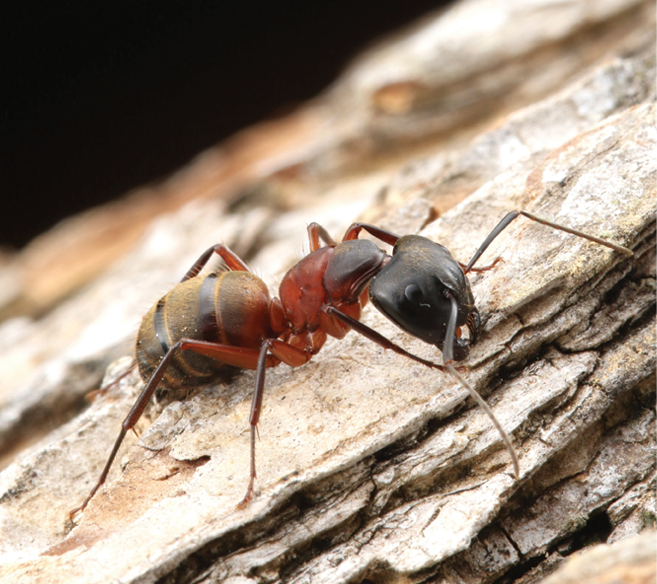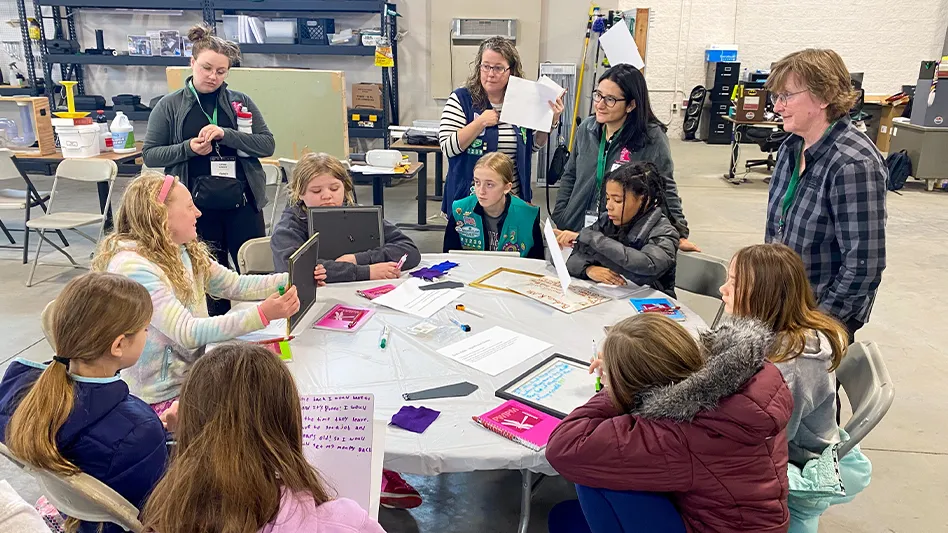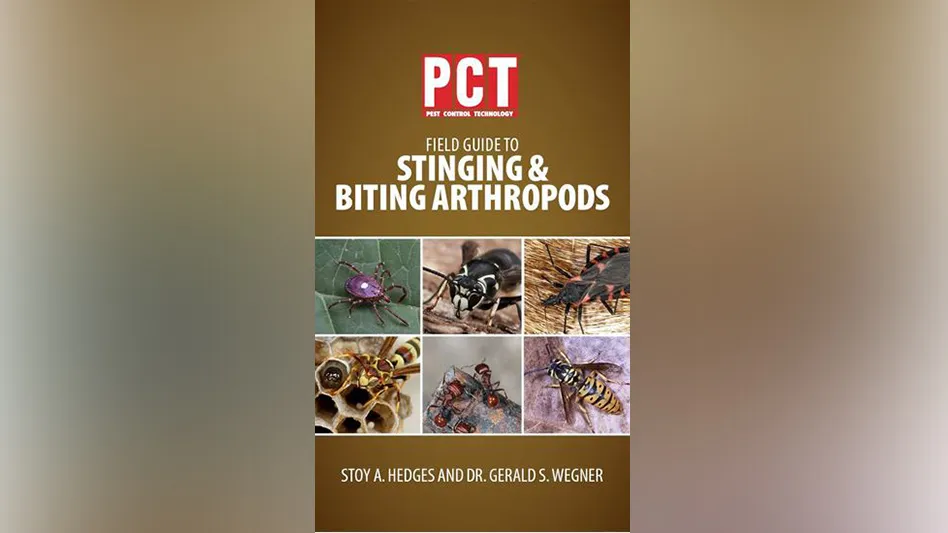
I call myself a structural entomologist because I focus on those arthropods that invade buildings. Structural pests have taught me countless lessons over my nearly 40 years in the pest control industry. They continue to teach me each day I get into the field, showing me new places they like to hide, different behaviors than I’ve seen before and mostly, that I still have much to learn.
Of all the pests that plague structures, ants are my favorite, followed closely by spiders. Ants are by far the most dominant insect on the planet so it’s no surprise they prove to be the most difficult to keep out of homes and businesses. I have been fascinated by ants since I was a child. Early on they taught me not to sit on their nest while in the yard — to look before I sit if I wanted to avoid ants in the pants.
EARLY EXPERIENCE. My first encounter in controlling ants was in a house trailer where what were likely odorous house ants were exiting the ceiling. The owner of the small company I worked for during summers between school years at Purdue University showed me how to apply Kepone bait, which was the only commercially available ant bait at the time. I then began to service homes infested by pavement ants and carpenter ants as these were the
two primary ant pests in Indiana. After several years working in the field in Indiana, I moved to Houston as an entomologist/sanitarian for Big State Pest Control. With its subtropical climate and insect diversity, Houston proved to be the ideal classroom for a young structural entomologist. Though I was an entomologist, I still had to learn how to identify all the new ants that I found in and around structures — fire ants, Pharaoh ants, acrobat ants and little black ants, among others. Later, in other jobs, I traveled the country encountering even more different ants and learned which strategies worked to keep them out of structures.
One of my first lessons involved the importance of the customer interview. A homeowner in Indiana would see ants during warm days in the early spring. Through her description, I knew these were carpenter ants and asked her to show me where they were seen. I also asked about possible water leaks in the home. All sightings were in one bedroom and almost always along one wall. She related that she’d once had a leak around one of the windows on that wall. Drilling and treating the wall voids under and around that window solved this problem. Asking questions helped pinpoint the area to treat.
PRACTICE MAKES PERFECT. In the early to mid ’80s, Pharaoh ants were particularly difficult to control as effective ant baits were almost non-existent. The IGR Pharorid by Zoëcon was available, which we mixed into our own food-based baits and placed out in pieces of plastic straws. Through experimentation, we found that baiting done for one month followed by residual treatments was an effective strategy. It was important to check baits weekly and add fresh baits because larger infestations could clean out bait placements. In one case, Pharaoh ants cleaned out 50 bait placements in one room overnight so the lesson was when an infestation was large and had been inadequately treated for long periods, the more baits the better that first two weeks.
Knowing that Pharaoh ants used wires and plumbing to move inside walls, we began to place baits inside each outlet and switch box and into and next to each plumbing penetration. This strategy had the added benefit of keeping the ants’ foraging activity hidden behind walls and thus immediately decreasing sightings by customers. I added the technique of wiping away ant trails with a soapy, wet sponge back to outlets and other locations where ants were known to exit the walls and to place baits in those areas. This helped keep ant activity hidden from customer view.
Very early on in Orlando, I was asked to consult on a house that had a persistent Pharaoh ant infestation despite a comprehensive baiting program inside. It was at this house I learned how much Pharaoh ant activity occurs outdoors, thus we needed to begin incorporating exterior baiting into Pharaoh ant baiting programs. At the house, I discovered more than 15 separate colonies living under the edge of the shingles above the soffits, inside the soffits and in leaf litter accumulated in the gutters and on the roof. A number of years later, the USDA in Gainesville, Fla., conducted a study showing Pharaoh ants could be effectively eliminated indoors by baiting only outside. During warm weather, they discovered this species spent more time foraging outside than inside. It is recommended to bait both indoors in walls and outdoors when dealing with Pharaoh ants.
Once, I spent a day riding with a pest professional and a customer was having a real problem with crazy ants indoors. I watched the professional as he completed a perimeter treatment with his truck-mounted sprayer. As he worked, I watched him step over likely crazy ant nesting sites without taking time to investigate them. I stopped his work and asked him to turn over a stone where he found a crazy ant colony and then to pull ivy away from the trunk of a tree close to the house. Under the ivy was a huge ant colony mere feet from the building itself. This is how I would teach professionals how to solve ant problems, by showing them the sites where colonies could be found and to treat these immediately, thus reducing the potential number of ants that could invade the building.
ANTS ALL OVER. Over the years, I’ve observed many service and sales professionals walk right by likely ant nesting sites. In one case in Louisiana, I saw a crazy ant trail running up a wall onto a second-floor balcony. The homeowner, when asked, said he’d see the ants on the balcony but not in the house...yet. I watched the service professional walk up, see the trail and then return to his vehicle to get ant baits. First, professionals should carry a duster, baits and a sprayer with them as they inspect in order to address ant colonies as they find them — it saves time. Before the professional could place bait, I asked him to lift the potted plant that was located right next to the trail going up the wall. Underneath was a huge crazy ant colony. He treated this trail using a residual spray and then drenched the ants in the soil of the potted plant and treated the trail on the wall. Directly addressing the colony — therefore the source — of this ant trail provided complete and immediate relief from this particular ant colony. Around this same house, we found fire ants living under and in several other potted plants and rover ant colonies in other planters. From then on, I am sure that professional always stopped to look at potted plants.
During a break on a photo shoot in south Florida, I wanted to see what ants I could find just by pulling grass and vegetation way from the foundation. Surprising to me, I found nine different colonies of seven different species of ants located in the space between the ground and the foundation. One of these species were trapjaw ants, which was the first time I had found them in the wild. Of the other six ant species, five of them were structure-infesting species. I’ve also found ant colonies simply by flooding this soil/wall junction along the foundation using a water hose.
In another case in Tennessee, I rode with a professional to a house where odorous house ants (OHA) were being seen in the kitchen. The professional wanted to place baits, but I explained that almost always OHA infestations originate from outside. I had him use his hands to move the mulch and leaf litter next to the house, which revealed up to a dozen subcolonies next to the house. He used his sprayer to thoroughly drench these sites, making sure to move the mulch and soil to really penetrate each colony. Interestingly, just four days before, the customer had put in the plants and the mulch; before, the area had been bare ground. Due to the new mulch and watering the area, OHA colonies moved into this now prime nesting site in a couple of days and began entering the house.
Riding with a commercial professional in Las Vegas, we visited a sandwich shop with an emergency ant call. In the shop, along the baseboards was a nice trail of Argentine ants. The professional wanted to bait these ants, but I directed him outside. I’ve learned most all inside ant infestations predominantly originate from outside. The ants here were entering under a door to the covered walkway outside. I noticed them trailing to an expansion joint in the walkway that ventured all the way to the back of the store. Looking that direction, I could see a band of gravel about 75 feet from where ants were going inside. This was the likely nesting site for the ants. Within this gravel bed over a layer of sand were hundreds of thousands of ants. Each site of ant activity was thoroughly drenched and the trail back to the door treated. Inside, the ant trail was wiped away with a wet, soapy towel.
Once, in Tampa, a waiting room on the second story of a hospital had ants. Upon inspection, crazy ants were foraging on bits of food behind a table and trailing around a wall and out a window onto the flat roof above. Going out the window, the trail was followed to the roof’s edge. Outside, we continued to follow the trail along a window ledge, down the bricks, across a sidewalk and into the voids of a retaining wall where we found the colony. The trail length from the wall to the waiting room was more than 300 feet. The trail was treated with a light residual spray from outside the window where ants entered along the roof, down the wall and all the way back to the wall. The voids in the retaining wall were treated with a residual dust. Inside, the trail was wiped away with a wet, soapy towel. Following the trail back to the colony, where feasible, allows for more permanent and immediate control than simple use of baits or a perimeter treatment. In some cases, this is not possible so baits and limited treatments can help keep ants out.
An office building had acrobat ants on the second floor by the outside wall. In a steel and glass building, I knew there was no wet wood (which is where acrobat ants prefer to nest) so I immediately went outside below that second floor area to inspect. I found a trail of acrobat ants going up the corner. Turning around, I looked for sites where I would find wet wood and saw one large tree about 75 feet from the building. Going there, I found a huge trail of acrobat ants disappearing somewhere up to a dead limb or tree hole. I followed the trail from the base of the tree up the sidewalk and to the building where the trail followed some type of structural guideline for about 85 percent of the trail. Because the ant colony was too far above the ground to be accessible and the fact that acrobat ants don’t particularly respond well to baits, I had the service professional treat around the tree trunk and the entire trail back to the building. The next day, thousands of dead ants were found and the professional was instructed to keep an eye out on each service to see if new ant trails came to the building and to treat these when found. Sometimes, regular treatments of ant trails are the only course of action to keep a particular ant colony out of a building.
SUMMARY. Though ants are by far the most difficult pests to control in homes and many other types of buildings, keep these lessons I’ve learned in mind:
- Identify the ant as each type/species has its preferred nesting sites and habits.
- Wherever possible, locate and treat colonies directly for immediate and longer-term control.
- Sometimes, you may need to follow a trail dozens, even hundreds, of feet to locate the offending colony.
- Most of the difficult pest species have multiple queens and subcolonies. Don’t stop when you find one or two. Extend your inspection to the edges of the property when necessary.
- Inspect corners, edges and other structural guidelines for ant trails. Remember ants use these guidelines for much of their trails.
- Pull grass, ivy and other vegetation away from walls, foundations and trees to look for hidden colonies. Focus inspections on the most likely sites t
- Focus inspections on the most likely sites to find your target ant. For carpenter ants and acrobat ants, think wood. For soil-nesting ants like fire and pavement ants, look for piles of displaced soil. For Argentine, OHA and crazy ants, look at piles, leaf litter and mulch for subcolonies.
- Look in and under every potted plant or item on the ground outside.
- Carry treatment materials and equipment with you while inspecting for ants. When a colony is uncovered, you’ll want to treat it directly, otherwise the ants may move the colony in the minutes it takes you to get back with your equipment.
- Baits can be an effective tool, especially for Pharaoh and rover ants, but avoid becoming too reliant on them. Use baits to supplement direct colony treatments or when the offending colony cannot be located or is not within reach (e.g., high in a tree or on an adjacent property).
- Bait Pharaoh ants indoors and outdoors.
- Treat trails where appropriate to help prevent ants from invading inside—especially helpful when the offending colonies are not accessible.
- Perimeter treatments are useful tools to help deter ants from entering, especially with high ant activity (e.g., Argentine ants, crazy ants). Perimeter treatments, however, should be combined with finding and treating as many colonies as possible. The fewer ant colonies on a property, the less likely ants will invade the structure.
The author is a consultant based in Eads, Tenn.

Explore the April 2018 Issue
Check out more from this issue and find you next story to read.
Latest from Pest Control Technology
- Gaining Control of Structure-Infesting Carpenter Ants
- Big Blue Bug’s Brian Goldman Receives Rhode Island Small Business Person of the Year Award
- UF Researchers Examine How Much Bait it Takes to Eliminate a Subterranean Termite Colony
- Women in Pest Control Group Continues to Grow, Provide Opportunities in the Industry
- NPMA Announces Results of 2024-2025 Board of Directors Election
- Massey Services Acquires Orange Environmental Services
- Hawx Pest Control Wins Bronze Stevie Award for Sustainability
- Abell Pest Control Highlights Growing Tick Activity Across Canada





